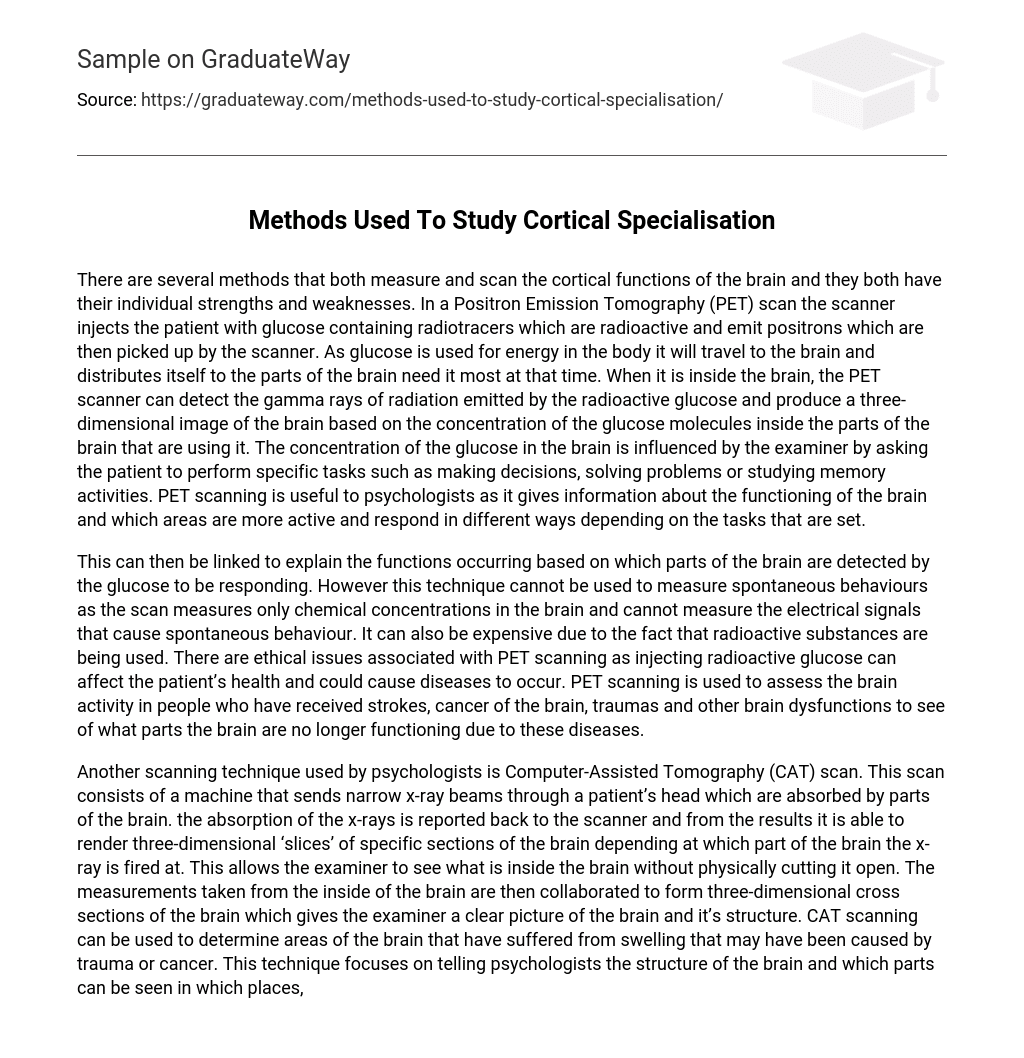Positron Emission Tomography (PET) scan is a method for measuring and scanning the cortical functions of the brain. It involves injecting the patient with glucose containing radiotracers emitting positrons, which are then detected by the scanner. The glucose travels to the brain and distributes to energy-depleted areas. Using gamma rays emitted by radioactive glucose, the PET scanner creates a three-dimensional image based on glucose concentration in active brain regions. Psychologists can manipulate this concentration by having the patient perform specific tasks and identify areas that respond differently depending on the task at hand. Therefore, PET scanning is valuable for understanding brain function.
The detection of glucose in different areas of the brain can provide insights into their functions. However, this approach is not suitable for measuring spontaneous behaviors as it only measures chemical concentrations and does not detect electrical signals. Additionally, the use of radioactive substances in PET scanning can be expensive and raise ethical concerns about its impact on patient health and potential disease progression. PET scanning is frequently used to assess brain activity in individuals with strokes, brain cancer, traumas, or other brain dysfunctions to identify specific areas affected by these diseases.
Psychologists also utilize Computer-Assisted Tomography (CAT) scan as another scanning technique. This procedure involves sending narrow x-ray beams through the patient’s head, which are then absorbed by different parts of the brain. By utilizing x-ray absorption, the scanner generates three-dimensional “slices” of specific sections of the brain, enabling examiners to visualize its internal structure without requiring incisions.
The collected measurements are combined to create clear three-dimensional cross sections that offer a comprehensive view of the brain’s structure. CAT scanning is particularly effective in identifying swelling caused by trauma or cancer and provides information about various regions and structures within the brain. However, it does not measure functional impulses or signals.
Ethical concerns associated with CAT scanning resemble those raised with PET scanning regarding potential radioactive harm; however, CAT scanning typically causes less damage than PET scans. Moreover, it is a non-invasive procedure that eliminates the need for needles or incisions when introducing substances into the body, thereby reducing stress for patients undergoing this process.
MRI scanning is a non-invasive technique that utilizes radio waves and magnetic fields to generate detailed images of the brain. This method excels in capturing structural detail and offers precise information for essential treatment. Psychologists can also employ functional MRI (fMRI) to examine neural activity by swiftly scanning the brain at a lower resolution. Although MRI scanning has drawbacks such as being costly, time-consuming, and distressing for patients due to its loud noise, it has proven invaluable in diagnosing diseases like sclerosis that cannot be identified through CAT scans.
A Post Mortem Study is the examination of the brain after death to investigate the effects of brain anomalies and diseases, such as brain tumors, strokes, and trauma. This method is used on deceased patients who experienced specific neurological issues during their lifetime and requires an explanation for the cause of their disease.
Psychologists can analyze the brain tissue under a microscope to study the hormones, toxins, and neurotransmitters present. This analysis reveals the exact events and causes that occurred in the brain. Post mortem studies are valuable because they allow for the identification of rare problems and diseases related to specific brain regions. Once identified, these conditions can be recognized in other patients, enabling treatment before it becomes terminal.
In addition, post mortem studies provide detailed structural information about the brain. They reveal abnormalities caused by the disease that led to the patient’s death, such as differences in size between different brain regions.
The studies do not provide enough information about how the living brain functions. This is because studying it internally can only be done after death. Moreover, determining the cause and effect of diseases is difficult because the process of dying could have affected both the brain and its related conditions. As a result, psychologists may never know if a disease caused a patient’s death or if other factors were involved.
In order to investigate why his patient Tan had difficulty speaking, physician Paul Broca conducted a post-mortem study on him. Tan was only able to say the word ‘tan’. Broca discovered that damage to Tan’s left frontal cortex, which was caused by contracting syphilis, resulted in his limited speech ability. Additionally, by linking speech deficits to brain damage, Broca concluded that language primarily resides in the left hemisphere of the brain. This important finding revealed that the left hemisphere controls the brain’s speech centers.
Electroencephalography (EEG) is a non-invasive method that uses electrodes on the scalp to record the brain’s electrical activity. It detects voltage fluctuations in brain neurons caused by current flow, measuring neural activity and brain waves. This procedure takes approximately 20-40 minutes and does not cause any harm to the brain. Unlike PET scans, EEGs provide information on specific areas of the brain and can measure spontaneous behaviors as they rely on electrical signals instead of chemicals. Additionally, this affordable and straightforward method enables researchers to track changes over time.
However, EEG lacks sensitivity in tracking individual neurons, which prevents it from providing a detailed scan of brain signals. Additionally, it does not offer any structural information as the signals are interpreted as computer values rather than images. EEGs are effective in diagnosing epilepsy because the disorder exhibits specific arrhythmic patterns within brain neurons. They are also beneficial in sleep studies, as they detect changes in brain activity levels during different sleep stages. EEGs can even determine brain activity levels in suspected brain-dead patients by observing neuron firing within their brains.a





